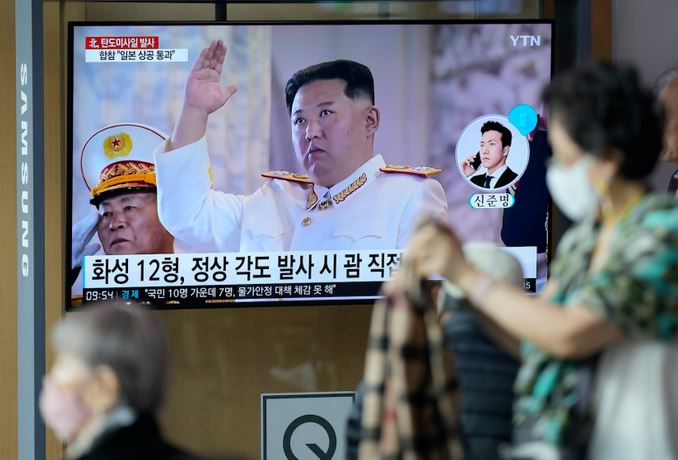
N Korea fires 2 more ballistic missiles toward sea
SEOUL
North Korea launched two short-range ballistic missiles toward its eastern waters Thursday after the United States redeployed an aircraft carrier near the Korean Peninsula in response to Pyongyang’s previous launch of a nuclear-capable missile over Japan.
The latest missile launches suggest North Korean leader Kim Jong Un is determined to continue with weapons tests aimed at boosting his nuclear arsenal in defiance of international sanctions. Many experts say Kim’s goal is to eventually win U.S. recognition as a legitimate nuclear state and the lifting of those sanctions, though the international community has shown no sign of allowing that to happen.
The latest missiles were launched 22 minutes apart from the North’s capital region and landed between the Korean Peninsula and Japan, South Korea’s Joint Chiefs of Staff said in a statement. The first missile flew 350 kilometers and reached a maximum altitude of 80 kilometers (50 miles) and the second flew 800 kilometers on an apogee of 60 kilometers.
The flight details were similar to Japanese assessments announced by Defense Minister Yasukazu Hamada, who confirmed that the missiles didn’t reach Japan’s exclusive economic zone.
He added that the second missile was possibly launched on an “irregular” trajectory. It is a term that has been previously used to describe the flight characteristics of a North Korean weapon modeled after Russia’s Iskander missile, which travels at low altitudes and is designed to be maneuverable in flight to improve its chances of evading missile defenses.
South Korea’s military said it has boosted its surveillance posture and maintains readiness in close coordination with the United States. Japanese Prime Minister Fumio Kishida said North Korea’s continued launches were “absolutely intolerable.”
The launches were North Korea’s sixth round of weapons tests in less than two weeks, adding to a record number of missile launches this year that has prompted condemnation from the United States and other countries.
On Tuesday, North Korea staged its most provocative weapons demonstration in years, firing an intermediate-range missile over Japan for the first time in five years. The launch led the Japanese government to issue evacuation alerts and halt trains.
Experts said the weapon was likely a Hwasong-12 missile capable of reaching the U.S. Pacific territory of Guam and beyond.
Other weapons tested earlier reportedly include Iskander-like missiles and other ballistic weapons designed to strike key targets in South Korea, including U.S. military bases there.
After the North’s intermediate-range missile launch, the United States and South Korea also carried out their own live-fire drills that have so far involved land-to-land ballistic missiles and precision-guided bombs dropped from fighter jets.
But one of the tit-for-tat launches nearly caused catastrophe early Wednesday when a malfunctioning South Korean Hyumoo-2 missile flipped shortly after liftoff and crashed into the ground at an air force base in the eastern coastal city of Gangneung. South Korea’s military said no one was hurt and civilian facilities weren’t affected.
After Tuesday’s North Korean launch, the United States, Britain, France, Albania, Norway and Ireland called for an emergency meeting of the U.N. Security Council. But the session Wednesday ended with no consensus, underscoring a divide among the council’s permanent members that has deepened over Russia’s war on Ukraine.
Russia and China during the meeting insisted to fellow Security Council members that U.S.-led military exercises in the region had provoked North Korea into acting. The United States and its allies expressed concern that the the council’s inability to reach consensus on North Korea’s record number of missile launches this year was emboldening North Korea and undermining the authority of the United Nations’ most powerful body.
North Korea has fired nearly 40 ballistic missiles over more than 20 different launch events this year, using the stalled diplomacy with the United States and Russia’s war on Ukraine as a window to speed up arms development.



